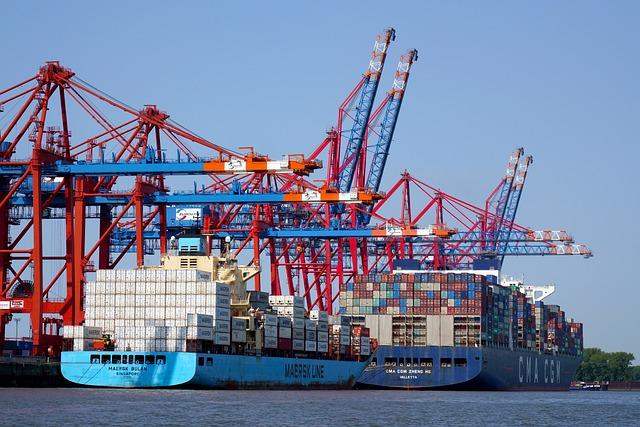In the ever-evolving landscape of global trade, few developments have had as profound an impact as the tariffs imposed by former President Donald Trump during his administration. these tariffs, aimed primarily at china, not only altered the dynamics of U.S.-China relations but also reverberated throughout Asia’s intricate trade networks. As countries in the region seek to adapt to the shifting economic terrain, many nations are exploring new alliances adn trade routes that could effectively exclude the United States from pivotal trade agreements. This article delves into how Trump’s tariffs are reshaping trade relationships in Asia, perhaps sidelining the U.S. and paving the way for a restructured economic order that prioritizes regional partnerships over conventional trans-Pacific ties. through a closer examination of these developments, we can better understand the long-term implications for global commerce and the U.S.’s position on the world stage.
Impact of Trump’s Tariffs on Asia’s Trade Dynamics
The imposition of tariffs by the Trump administration has considerably shifted the landscape of international trade in asia, prompting a reevaluation of supply chains and trade partnerships. As countries in the region adapt to the new tariff realities, several key trends are emerging that illustrate a potential reordering of trade dynamics:
Increased Regional Cooperation: Many Asian economies, such as Japan, South Korea, and the Association of Southeast Asian Nations (ASEAN) members, are emphasizing intra-regional trade, fostering agreements that could potentially sidestep the U.S. altogether.
China’s response: In retaliation to U.S. tariffs, China is actively seeking to strengthen its trade relationships with neighboring countries, encouraging investments and the establishment of a more integrated economic bloc in Asia.
Moreover, the long-term consequences could be profound for American businesses, wich may find themselves at a competitive disadvantage. As Asian economies pivot towards each other, the gradual exclusion of the U.S. from significant trade agreements becomes increasingly plausible. A snapshot of this trend can be seen in the evolving trade agreements across the region:
Trade Agreement
Participating Countries
Potential Impact on U.S. Trade
RCEP (regional Thorough Economic Partnership)
China, Japan, South Korea, ASEAN members
Increased trade within Asia, potentially sidelining U.S. exports
TPP (Trans-Pacific Partnership, without U.S.)
Japan,Australia,and other Pacific Rim countries
Creation of new trade norms that exclude the U.S.

Shifts in supply Chains and Their Economic Implications
The recent implementation of tariffs by the Trump administration has catalyzed significant shifts in global supply chains, notably across Asia. Countries such as China have begun to reevaluate their trade relationships, leading to an acceleration in regional trade agreements and collaborations. This realignment not only aims to mitigate the economic burden of U.S. tariffs but also fosters a more interconnected Asian economic bloc that prioritizes local supply networks. Key outcomes of these shifts include:
Increased regional trade agreements: Countries may prioritize partnerships with neighbors,fostering trade pacts that exclude U.S. goods.
Supply chain diversification: Asian manufacturers are exploring alternatives to Chinese production,investing in countries like Vietnam and India.
Changes in consumer behavior: rising tariffs could lead consumers to prefer domestically produced goods or those from countries with favorable trade terms.
As businesses adapt to these changes, economic implications are becoming increasingly evident. The revision of supply chains will not only affect manufacturing timelines and costs but could also lead to long-term shifts in economic power dynamics within Asia.A closer examination reveals critical factors, including:
Factor
Potential Impact
Tariffs on Chinese Goods
Increased production costs for U.S.companies relying on Chinese imports.
Regional Trade Agreements
Stronger economic relationships among Asian nations may marginalize U.S. influence.
Diversification of Supply Chains
Reduced dependency on China could stabilize regional economies but create volatility elsewhere.

Regional Trade Agreements: Opportunities for Exclusion of the U.S
The shifting landscape of regional trade agreements has opened the door for many Asian countries to strengthen their economic ties while sidelining the United States. As tariffs imposed by the Trump administration continue to create friction, neighboring nations are likely to pursue collaborative economic frameworks that prioritize mutual benefits. this evolution could manifest in several ways, including:
increased bilateral agreements: Countries might opt for direct trade agreements that exclude the U.S., fostering stronger regional cooperatives.
Emergence of new trade blocs: Nations could band together to form alliances, effectively reducing dependence on U.S. markets.
Strengthened supply chains: By focusing on intra-regional supply chains, these countries may enhance their economic resilience.
As the U.S. finds itself potentially sidelined, it is crucial to examine how these new trade agreements might impact global economic dynamics. As a notable example, countries within Asia may benefit from reduced tariffs and improved access to each other’s markets. This could lead to a significant shift in trade flows, as illustrated in the table below:
Country
Potential Trade Growth (%)
New Trade Agreements
Vietnam
15%
ASEAN+3
Japan
10%
RCEP
South korea
12%
Korea-ASEAN FTA
This potential exclusion of the U.S. from significant trade agreements not only redefines the contours of Asian trade but may also force a recalibration of U.S. trade policy. As these countries forge their pathways toward enhanced economic collaboration, the U.S. must navigate a complex array of challenges to reclaim a foothold in the rapidly transforming trade landscape.

strategies for U.S. Businesses to Navigate Changing Markets
As tariffs reshape the landscape of international trade, U.S. businesses must adopt proactive strategies to remain competitive in a fluid market.Diversification of supply chains is crucial. By identifying option suppliers in countries unaffected by new tariffs, businesses can mitigate risks associated with sudden price hikes and shortages. Additionally, fostering strong relationships with local partners can enhance market intelligence and provide insights into regional trends. Companies should also invest in technology to improve operational efficiency and reduce costs, which can be essential when facing increased import tariffs.
Moreover, understanding consumer sentiment and adjusting marketing strategies accordingly can position businesses favorably. Consider these tactics:
Localized marketing campaigns that resonate with regional preferences.
Responsive pricing models to adapt quickly to changing costs and consumer behaviors.
Transparent dialog with stakeholders regarding price adjustments and product availability.
By implementing these strategies, U.S. businesses can navigate the challenges posed by evolving trade policies and market dynamics while striving to capitalize on emerging opportunities.

the role of China and Its Influence on Asian Trade Partnerships
China’s ascent as a dominant economic force in Asia has significantly reshaped trade relationships across the region. As the world’s second-largest economy, it plays a pivotal role in determining the flow of goods and services among Asian nations. The Belt and road Initiative, a centerpiece of China’s foreign policy, has further cemented its influence by promoting infrastructure investments and fostering economic partnerships.This initiative has facilitated trade routes and access to markets, thereby enhancing connectivity among countries such as:
Vietnam
Thailand
Singapore
Malaysia
As the U.S.imposes tariffs on various imports, Asian countries may increasingly seek to pivot towards China for trade.Such a shift is evident in emerging trade agreements that focus on reducing dependency on American markets. China’s strategy frequently enough includes offering favorable terms to its neighbors, enhancing bilateral trade at the expense of traditional partners. the evolving landscape is characterized by:
Country
Proposed Trade agreements
Potential Benefits
Indonesia
China-Indonesia Free Trade Agreement
Increased exports and investment
Philippines
China-Philippines Economic Zone
Infrastructure growth
Thailand
RCEP Participation
Access to larger markets

Future Scenarios: How Tariffs May Shape Global Trade Patterns
the imposition of tariffs can potentially redirect trade dynamics across Asia, influencing established patterns as countries reassess their economic partnerships. Nations such as China, Japan, South Korea, and Vietnam may turn inward or towards one another to mitigate the effects of U.S. tariffs. In this context, the rise of trade blocs and regional agreements could become more pronounced, leading to a more interconnected Asian market that operates independently of American influence. For instance, Asian economies might choose to fortify initiatives like the Regional Comprehensive Economic Partnership (RCEP), collaboratively reducing intra-regional barriers while capitalizing on shared economic interests. this shift can result in enhanced collaboration in industries like technology, manufacturing, and agriculture, ultimately reshaping how goods flow across the region.
Furthermore,as tariffs reshape global supply chains,countries may prioritize strategic partnerships that bolster their economic standing and mitigate reliance on U.S. markets. This reorganization could lead to diversification in sourcing and manufacturing locations, especially among nations that are traditionally dependent on American trade. Key players are likely to pursue bilateral agreements that establish favorable terms devoid of U.S. involvement, fostering a novel trade landscape. Below is a simplified representation of potential shifts in trading relationships among Asian countries:
Country
Potential Trade Partners
Industries Affected
China
Japan, South Korea
Electronics, Textiles
vietnam
India, ASEAN
Footwear, Machinery
Japan
Australia, India
Automobiles, Steel

The Way Forward
As the economic landscape in Asia continues to evolve in response to shifting U.S. trade policies, the implications of Trump’s tariffs on regional commerce and alliances become increasingly profound. The potential for a reordering of trade dynamics not only presents challenges for American businesses and exporters but also paves the way for Asian nations to strengthen ties among themselves, potentially minimizing U.S. influence in the region. As countries seek to navigate this complex terrain, the resulting trade agreements and partnerships will likely reshape the future of Asia’s economic relationships. Moving forward, stakeholders on all sides must consider how these developments could redefine competitive landscapes and cooperative frameworks, ultimately determining the nature of trade in Asia and eliciting a need for reassessment of U.S. strategies in this pivotal area of the world. the unfolding narrative promises to be a critical chapter in the global economic story, one that will require careful observation and understanding in the months and years ahead.
—-
Author : Asia-News
Publish date : 2025-02-24 08:22:03
Copyright for syndicated content belongs to the linked Source.